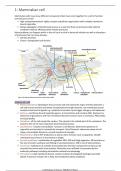Lecture notes
Microbiology Digital Notes Bundle (80+ pages!)
- Module
- Cell Biology of Disease
- Institution
- University Of Leeds (UoL)
- Over 80 pages of digital notes with visual aids - Condensed knowledge from 15 lectures The study notes cover: Notes 1-3: 1 - Bacterial Structures 2 - Bacterial Metabolism 3 - Bacterial Identification Notes 4-6: 4 - Introduction to Virology 5 - Viral Structures 6 - Viral Infection I ...
[Show more]



